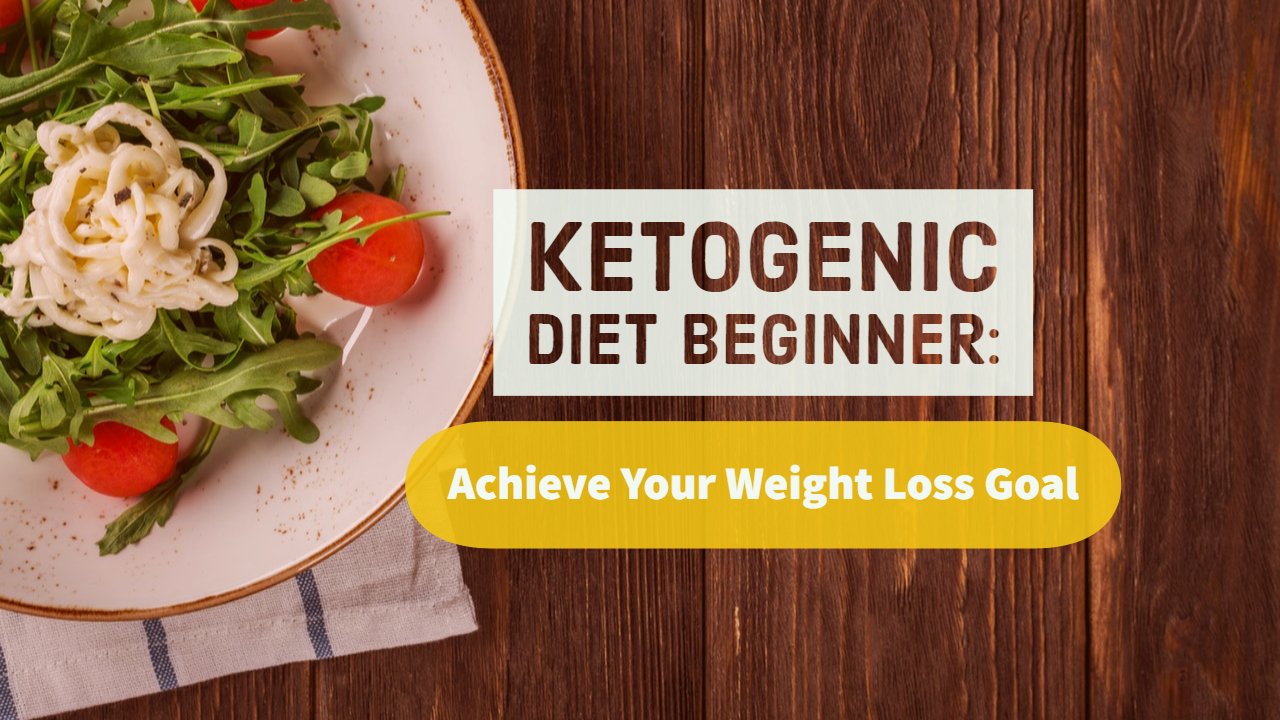In this post, you will learn exactly how to do Keto, what to eat what not to eat, and when to eat. You will learn the common problems that people experience when starting keto, the Keto flu and how to avoid them. We want to make keto truly simple for you and help you succeed in reaching your goals.
Introduction

You’ve probably heard about the keto diet. It’s the newest hype. Almost everyone is talking about it.
What does Keto mean?
Basically, the body can run on two different fuels which are sugar from carbohydrates such as bread, pasta, rice, and potatoes.
The other fuel is fat which includes real foods like eggs, meat, avocados, butter, olive oil, and nuts.
The keto diet is a very low carb diet. The brain can become fueled by fat. When the body is out of sugar, fat is converted in the liver into energy molecules called ketones that fuel the brain.
And the diet that results in this is called ketogenic, meaning it produces ketones. And that’s why the diet is called the keto diet.
Being fueled mostly by fat. A state called ketosis has many benefits including that you become a fat-burning machine. It’s perfect for weight loss without hunger burning fat 24/7 even when you’re sleeping. Because it gives you tons of energy, you’re basically never run out.
Why the keto diet has become super popular in the last few years?
The foundation of keto is something old that you’ve heard a lot of times. It’s a strict low carb diet, It’s a gluten-free diet, It’s similar to the paleo diet and it’s very close to the old and well-known Atkins diet.
The basic idea is super simple and based on real foods. You simply avoid most carbohydrates like sugar, processed junk food, bread pasta, rice, etc. Instead, you eat meat, fish, eggs, vegetables, and natural fats like butter.
What is different with keto?
It is that it’s a supercharged low carb diet where you can make sure you get the maximum benefits. So keto is a supercharged version of an old idea.
Similar diets have been tried for decades even centuries. These similar diets keep returning more popular than ever because they work. And this could have an evolutionary explanation as our ancestors did not eat refined carbohydrates or sugar like we do today. So our bodies may not be adapted to those foods. Modern science proves that it works.
On a keto diet, most people can lose excess weight without hunger and a number of health issues tend to improve. Most importantly a diet is not just used as a temporary fix. Many people enjoy it is a long term lifestyle. Not just for weight loss but for long term health and well-being and staying fit year-round.
Many people feel energized full of mental clarity and have stable blood sugar levels. Most of the hunger disappears, cravings for sweets foods are reduced, so there’s no need to snack all the time anymore.
People save time by being happy with fewer meals. They eat delicious food whenever they’re hungry and there’s not even any need to count calories.
Most people feel so satisfied with keto that they can eat when they’re hungry and still eat less and lose excess weight. They don’t even have to exercise.
Now, of course, some exercise is good for you for health and feeling your best, but it’s not required for weight loss and certainly not on Keto.
How does a keto diet work?
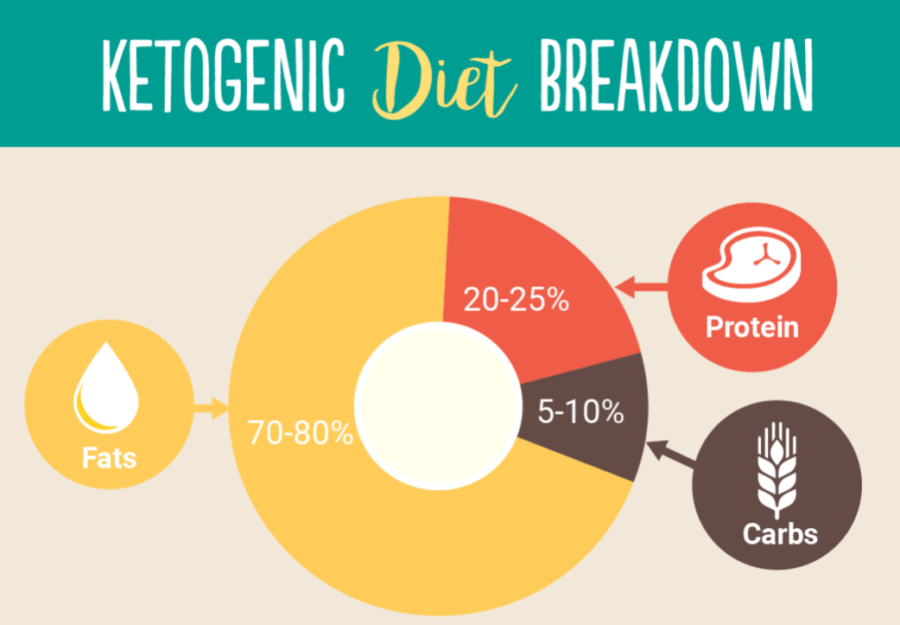
A keto diet turns you into a fat-burning machine that may reverse many common health issues. Keto makes it very easy to lose excess weight, stay satisfied for long periods of time, and control your blood sugar.
Your body will burn fat and your brain will burn ketones that are also made from fat. It’s important to realize that this is very different from what is considered normal today. All around the world, there is a massive obesity epidemic going on. Most people in the modernized world are already overweight or obese due to too much sugar in people’s blood.
Every second American is now predicted to get type 2 diabetes in their lifetime. It’s a global problem happening in China, India, and Europe. Which leads to terrible complications. Excess fat on people’s bodies and excess sugar in the blood. Most likely it affects you and those around you.
So why is it happening?
All around the world, we now have easy access to high carb high sugar foods 24/7. Foods that also hyper-palatable, meaning they are so rewarding that they are potentially addictive.
The average person is likely to eat and drink sugar or starch many many times per day. And every time we do that we increase the amount of sugar in our blood and we make sure our bodies burn sugar.
The problem with burning primarily sugar is that this shuts down our bodies fat burning via the hormone insulin. When you eat carbs you raise blood sugar levels and insulin levels rise. Insulin is the body’s fat-storing hormone, it tells your body to store fat you eat for later.
So the sugar is burned first and the fat is stored for later and that’s the problem in a nutshell because later never comes. Nowadays we’ll soon eat again. And we’re not just talking about the obvious junk food like doughnuts. Starchy foods like bread or pasta rapidly break down in the gut turning to pure glucose a simple sugar raising blood sugar and insulin levels. Bread, pasta, and rice, all starchy foods turned to simple sugars in the gut.
What does all this have to do with Keto?
A keto diet is the exact opposite. Instead of burning sugar all the time we burn fat. Obviously, Keto is not the only healthy way you could eat but it is the most powerful diet to completely reverse diseases caused by too much sugar and carbs, including obesity. Because instead of constantly eating sugar and starch all day we don’t do it at all. At least almost not at all.
A keto diet is a very low carb diet. It is moderate in protein meaning you should still eat a normal amount of protein. What you need to repair and maintain the body’s tissues like before. But the energy that you need what you used to get mostly from sugar or carbs, you will now get from fat.
On a keto diet, your body is fueled by fat. All the muscles in our bodies can be fueled directly by fat. But the brain however cannot and that’s where we come to the word “Keto“, the short word for “ketogenic“.
Ketones:
When you eat very few carbs your body will take fat and convert it in the liver to small energy molecules called “ketones“. And ketones are great fuel for your brain. On Keto, your brain will be burning fat via ketones. This is actually a function that the body needs. Whenever you don’t eat for some time, if you’re fasting or starving the stored sugar quickly runs out and the body starts producing ketones from fat to feed the brain.
You don’t have to do a keto diet to get into ketosis. You could also just fast for a day or two and you would also get into ketosis and burn lots of fat. The nice thing is that you don’t have to starve or fast for a long time to achieve that because a keto diet also does it. You obviously can’t fast forever, but you can do a keto diet for life.
Bottom line
The bottom line is that Keto makes you a fat-burning machine. While someone else might be running on a treadmill for an hour to burn some fat. You will be burning fat 24/7 even when sleeping.
It’s the ultimate diet for weight loss and it can help you feel greater and perform better. On keto, you’re never likely to run out of fuel. Your body can only store carbs for energy for a few hours or maximum one day.
This means that if you were a sugar burner you will get hungry again fast. You’ll have to eat and prepare food all the time and if you don’t you’re likely to feel hungry and tired and miserable.
On the other hand, the body stores fat with enough energy for weeks or even months and on a keto diet, your body and brain have constant access to this.
You will be able to just keep going. Feeling energetic and satisfied and great without ever having to stop for a snack. You could easily skip a few meals should you want to save tons of time and money all while burning fat. It’s no surprise that keto is a great way to lose weight.
How much and what to eat (and avoid)
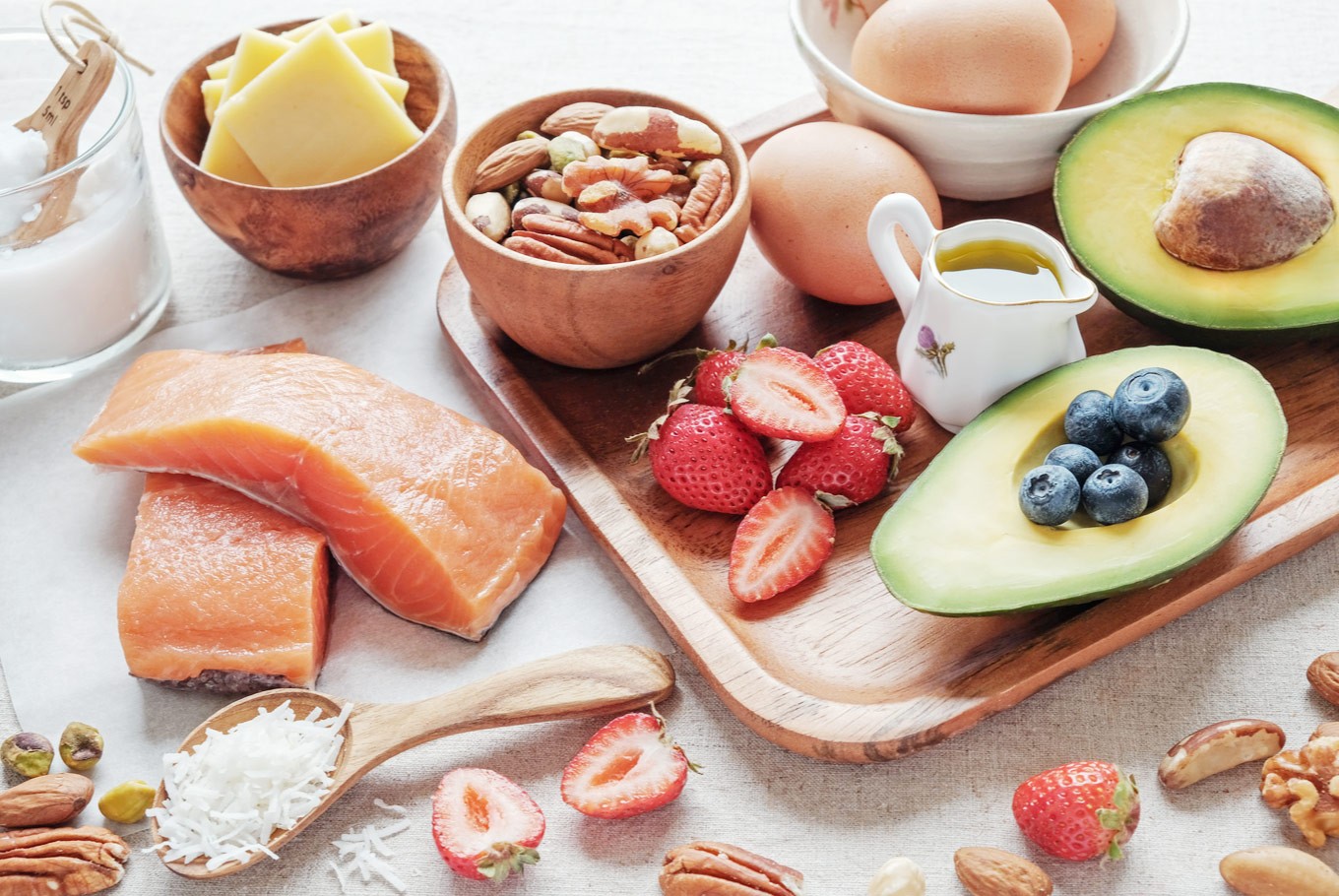
A keto diet contains very few carbs and a higher proportion of energy from natural fat. The protein amounts should be moderate.
The diet is based on real food like meat fish eggs vegetables and natural fats like butter all from fatty foods like avocado, salmon or olive oil.
Avoid the carbohydrate-rich foods like sugar, sweets, and starchy foods, bread, pasta, rice, and potatoes. A simple way to explain the difference between regular food and Keto foods is that you remove the large portion of carbs rice, potatoes or pasta and replace it with vegetables prepared in fats. For example, veggies fried in butter or salads with olive oil.
So how much should you eat?
Well, you can eat when you’re hungry until you are satisfied. You don’t need to count calories or need any pills. You don’t need special products and no meal replacements on a Keto diet.
Another important difference waiting until you’re hungry to eat feels easy on keto, because your body can now switch directly to burning your body fat when needed.
On a carb diet, you will get sugar cravings and feel tired if you don’t eat all the time. But on a keto diet, you get more energy when you’re hungry. Now once you Keto, hunger is the best spice.
A common keto rule is to stay below 20 grams of carbs per day. A simple beginner’s rule to achieve that is to stick to food with less than 5 percent carbs.
What to eat and what not to eat on the keto
When it comes to meat just choose what you like. Beef, pork, poultry, Bacon. The fatty parts are good for you and so is the skin on the chicken. Try to choose organic and grass-fed beef if you can. It tastes better. It’s better for your health for the environment and for the animals.
When in doubt about processed meats like sausages, cold cuts, and meatballs. Just look at the ingredient list for carbs like added sugar or flour. Again less than 5 percent carbs.
Seafood is excellent. Everything is good. You can choose what you like. Fatty fish like salmon is great, but avoid breading as it’s full of carbs. And if you can find wild-caught fish that’s the very best with even more healthy omega 3 fats.
People often eat a lot of eggs on keto which is perfect and nutritious food. You can have them boiled fried in butter or is omelets whatever you want. Try to buy organic and if possible find eggs from free-range chickens. They are the best.
When it comes to vegetables a simple rule is that all vegetables growing above ground are good as they contain very few carbs. You can probably to pound a day maybe more and still stay in ketosis. Vegetables are good for you. Vegetables from below-ground tubers should be kept to a minimum on a keto diet as they contain a bit more carbs.
Potatoes including sweet potatoes should preferably be avoided. Vegetables are also a great and tasty way to eat good fat on keto. So it is perfectly fine to fry your vegetables in butter pour plenty of olive oil over your salad.
What kind of fat should you eat on the keto?
Use real butter and real heavy cream for cooking. Forget the old and obsolete fear of natural fat because now the food gets tastier and you get more satisfied.
You can also have rich sources like Bernays or Hollandaise sauce or garlic butter. Also, try coconut oil in olive oil.
Modern science proves that natural saturated fats including butter are fine to eat. While on keto don’t fear fat. Fat is your friend.
How much fat can you eat?
Just eat until you’re satisfied. And if you’re still hungry eat more fat. Other naturally rich dairy products are also good, not just butter. Like cheese, real full-fat cheese.
Don’t forget high-fat yogurt like Greek, Turkish, or Russian yogurt. But make sure there is no added sugar.
Why are the high-fat products the best choices?
It’s because they keep you for longer and you’ll want to eat less which is good as dairy products like yogurt and milk contains some milk sugar. And if you choose the highest fat options you will get fuller sooner and you won’t get a lot of milk sugar.
Low-fat products don’t keep you as satisfied. They taste worse and they may even be worse for your health. Low-fat yogurts of and have tons of sugar added to them. So they remove the natural fat and instead add the same sometimes more amount of calories in pure sugar. Low-fat milk should also be avoided. It could be called white soda. Try not to drink milk while on keto as the carbs do add up quickly, about 15 grams of sugar in one glass of milk.
Sugar and starch that you want to avoid are primarily found in sweets and bread, pasta, rice, and potatoes. The absolutely worst two things for your weight and health for soda and fruit juices as they contain a ton of sugar.
I’m sure you’ve heard the expression beer belly. And now you will know why beer cause is the term beer bellies because of all the bad carbs. A better choice is a glass of red wine.
Surprisingly fruit contains a lot of sugar. Try to view fruit as natural candy and eat it only occasionally. Berries are good they contain less sugar.
What should you drink on the keto?
The best drink Is plain water, carbonated or flavored if you want. Coffee and tea are great even with a moderate amount of milk or cream.
Classic keto food is real food without sugar or starch. You eat when hungry until you’re satisfied and this could be three times a day. If you add in intermittent fasting you could eat twice or maybe even just once a day. You can choose what feels right for you.
Common side effects on a keto diet

The keto flu:
Most people feel great on keto full of energy and mental clarity but not in the first week. There is something called the “keto flu” and in the first week, most people experience it especially on days 2 to 5.
You can feel like the flu headache, fatigue, perhaps you feel irritable inexperience a lack of motivation, perhaps some nausea. You’ll just feel unwell.
Fortunately, there’s a simple reason for this and there is a simple solution. Some people think of this week as detoxing from sugar getting off the sugar drug. Ending the carb dependency and adapting to burning fat instead.
When you start a Kito diet your levels of fat-storing hormone insulin drop. And this is what gets your fat-burning going.
Lowering insulin has few effects
Your kidneys will start excreting more salt and water. So you may experience your urine production increases and you’ll pee more. Until the body adapts to this you may end up a bit dehydrated and salt deficient and this can result in headache fatigue feeling irritable demotivated perhaps dizzy with some nausea.
Solution
The solution is very simple. Drink more fluids and make sure you get enough salt. The simple and tasty ways to drink a cup of bouillon one or two times per day.
An even simpler option if you don’t mind the taste is to dissolve half a teaspoon of salt in a large glass of water and drink that. Or any other way to get enough salt and water.
This can almost feel like magic within 15 or 30 minutes most symptoms of the keto flu usually just vanish. And you can keep doing this for as long as you need. You should probably do it at least once a day during the first week to feel good. And after that, if you feel you need it.
If you still don’t feel great, make sure you eat enough fat so that you’re not hungry and if you still don’t feel good you could add back some carbs. That will definitely take care of the initial keto flu.
Leg cramps:
This is caused by the increased urination and a connected loss of minerals like sodium and magnesium. Usually getting enough fluid and salt can stop leg cramps from happening, but occasionally supplementing with magnesium can be helpful.
Constipation:
Constipation also happens occasionally for some people. But note that when you eat highly nutritious foods like meat fish eggs and fat these foods are almost completely absorbed in the gut. So there will be less stuff left to get rid of and you may not need to go to the bathroom as often. That’s normal. Nothing is broken and there’s no need to fix it.
So when I talk about constipation I mean if the significant discomfort involved in again drinking enough and getting enough salt is helpful is dehydration can result in constipation. Eating nonstarchy vegetables can help prevent it and likely that’s enough.
Keto breath:
When you get into ketosis some people experience a characteristic smell from the breath, a fruity smell that can remind people of nail polish remover.
And this is the ketone body acetone. It’s a sign that you’ve started to burn tons of fat. Not everyone experiences this and for those who do it often disappears after some time as your body adapts.
Heart palpitations:
Now it’s not uncommon for people to experience that their heartbeats a bit harder and a bit faster initially. This can again be partially due to dehydration and salt deficiency because of reduced fluid volume in the blood can result in the heart has to be a bit more often. And again enough salt and water should help.
Reduced physical performance:
Don’t plan any personal records in the gym or fits of endurance during the first week or two. Because adapting to burning fat for fuel can take a few weeks so be kind to yourself and take it a bit easier at first.
If you don’t feel strong when exercising makes sure you’re getting enough fluid and salt because that is crucial for physical performance. And taking extra salt and fluid about 30 minutes before you exercise can make a huge difference.
Fat burning machine mode – “KETOSIS”
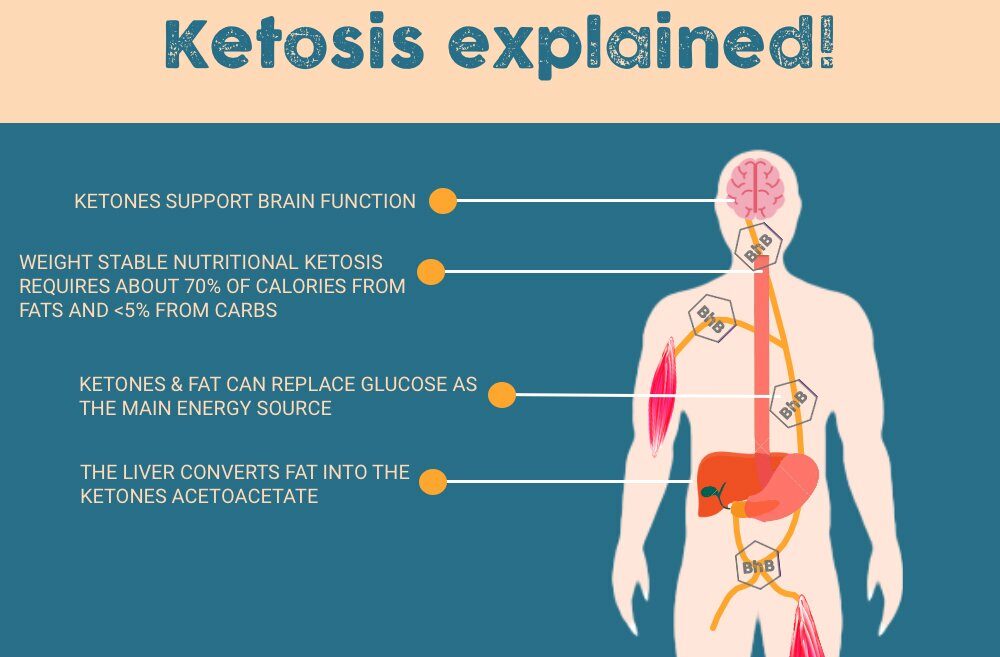
Perhaps you think all you have to do is eat a very low carb keto diet. Well, that’s often true. But it’s easy to regularly eat something with carbs in it by mistake. There are a few things besides carbs that affect ketosis. There are seven things to think about.
Restrict carbs to below 20 grams
Some people may be able to handle slightly more carbs and still be in ketosis. It is a bit individual but below 20 grams is a very effective level. Quite often just restricting carbs to very low levels results in ketosis so this may be all you need to do.
Restrict protein to moderate levels
Keto diet is a moderate protein diet where you eat the protein you need but not so much more. Large amounts of excess protein is converted to glucose in the body reducing ketosis. If you’re counting tried to stay below one gram of protein per kilogram or about two pounds of body weight per day.
Eat enough fat
This is the main difference between a keto diet and starvation. Starvation is where you avoid fat and carbs that is not sustainable. You will eventually get tired and hungry and give up. But a keto diet is sustainable and can make you feel great indefinitely.
So eat enough fat to feel satisfied. And if you feel hungry all the time you should probably add more fat to your meals like more butter more, olive oil, etc.
Avoid snacking
Eating more often than you need, just eating for fun or because it’s tasty or because there’s food around reduces ketosis and slows down weight loss.
Intermittent fasting
Eat only during eight hours of the day fasting for the other 16 hours. This is usually easy to do on keto and effectively boosts ketone levels while accelerating weight loss and type 2 diabetes reversal among other things.
Exercise
It boosts ketone levels a bit and it may increase weight loss and type 2 diabetes reversal slightly. Exercise is not necessary to get into ketosis but it can be helpful as a bonus.
Sleep enough
For most people at least seven hours per night on average and keep stress under control because sleep deprivation and stress hormones raise blood sugar levels slowing ketosis and weight loss.
Plus they make it much harder to stick to your chosen diet and resist temptations. Handling sleep and stress will not get you into ketosis on its own but it’s still worth thinking about.
Are you in ketosis?
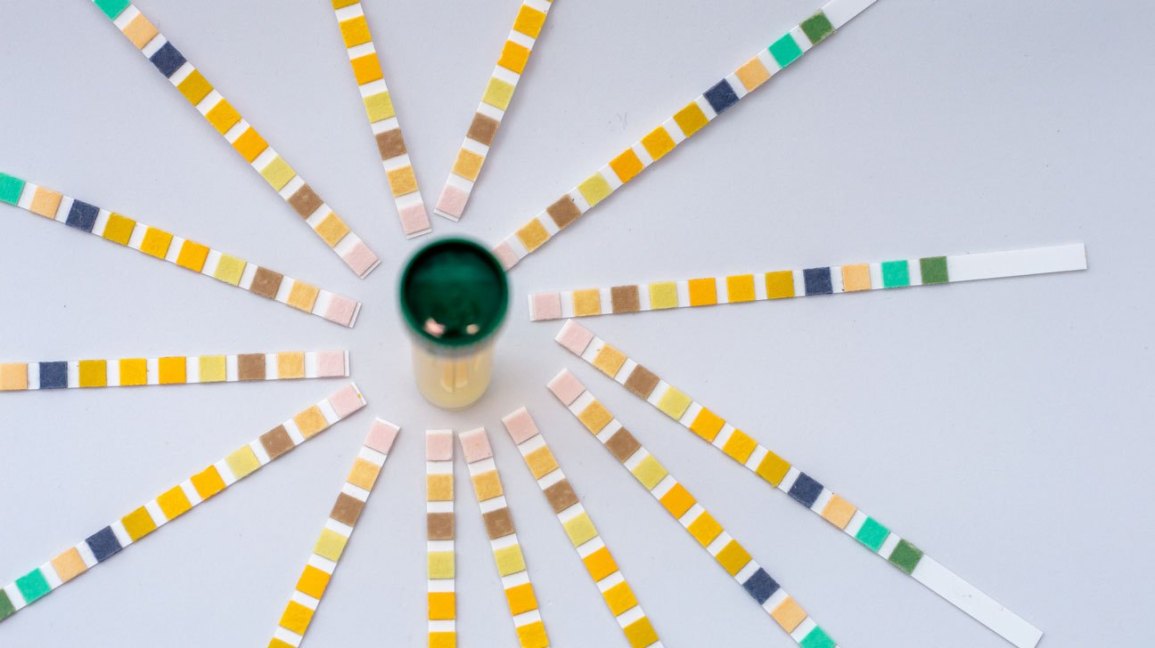
You can feel it or you can measure it. Simple as that. Measuring is the most certain way. But you’ll need to buy some equipment for testing urine or breath or blood. However, you don’t need to buy anything in order to feel that you’re in ketosis.
So how does it feel?
First of all many people experience a marked reduction in hunger. You just don’t need to eat as often anymore and cravings are reduced.
Secondly, people often feel an increase in energy levels. Perhaps even thinking more clearly. There may even be some euphoria. So these are all good things but a bit unspecific. Many things can make you feel good not just ketosis.
There are a few more specific things
Increased urination:
You’ll have to go to the bathroom a bit more often. This is because ketones end up in the urine.
Thirsty:
And this will secondly increase your thirst and you may feel a dry mouth if you don’t drink enough. Some people also experience a sort of a metallic taste in the mouth. If that happens it’s a clue that you’re in ketosis.
Track your ketone levels
You don’t have to measure ketones to be successful on a keto diet but it can be helpful for some people to make sure that they are doing it right. There are three different ways to measure ketones.
Urine strips:
This is the simplest and cheapest way to do it. Just dip a strip in urine wait for 15 seconds and the color-changing to dark purple shows you if you’re in ketosis. If you have the ketone body called a CTO acetate in your urine. You can get these strips cheaply at a regular pharmacy or via Amazon.
The con is you don’t get an exact measurement because the concentration of ketones in your urine depends a lot on how much fluid you do drink and it can get lower over time as your body adapts to ketosis and the kidneys start saving the ketones. It tells you very roughly how deep into ketosis you’ve been since last time you went to the toilet. So this is not the perfect test but it’s cheap and simple and for most people is all they need. If they even need to test.
Breath testing:
Breath-ketone analyses are a fairly simple way to measure ketones acetone in your breath. They are more expensive though and can cost 170 dollars an hour.
However, if you get one you can use it any number of times. So it’s a one time cost. There’s also some practice involved to get a correct measurement. You’ll have to breed out all of the air in your lungs.
Newer versions allow you to connect them to an app on your phone and it will show you your current level of acetone in your breath. There are some circumstances where the breath measurement won’t be accurate so it’s not a perfect test but it’s pretty good if you can afford it and it measures the amount of active ketosis going on right now.
Ketone-meters:
This is the most exact and shows the current buffet level of ketones in your blood, the beta hydroxide beta rate. The main disadvantage is that you’ll have to prick your finger for a drop of blood. They’re also a bit expensive. They used to cost about two dollars or more per test but still if you do a lot of testing the cost will add up.
With blood testing, you get the current exact value of the buffer ketones so it reflects exactly how deep into ketosis you’ve been over the last couple of days.
If you get a value over 0.5 you can consider yourself in ketosis. At 0.8 is mild ketosis and it’s fine. Between 1.5 and 3 it’s considered potentially optimal for mental performance and such and slightly higher is fine too
Ketoacidosis is a dangerous state and is pretty much impossible to get on a keto diet. It’s something that happens mostly for people with Type 1 diabetes who don’t get the insulin injections they need.
Ketoacidosis happens at over 10 mM, usually far higher. So it’s something different.
Weight loss on keto
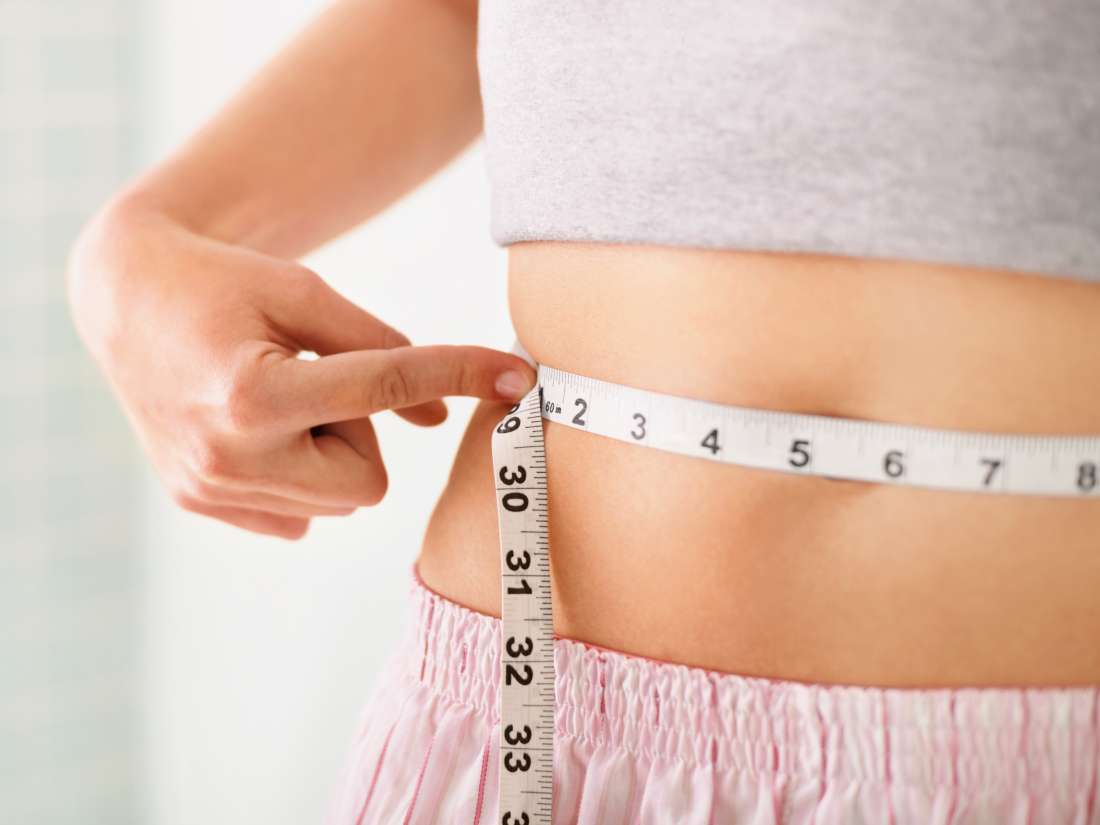
Keto maximizes fat burning when carb intake is very low. The body has no other choice but to burn fat for energy. It even converts fat in the liver into ketones to fuel the brain. So the whole body becomes a fat-burning machine.
Perhaps that’s why multiple high-quality scientific studies show that compared to other diets low carb and keto diet result in more weight loss.
How much weight loss should you expect?
This is highly dependent on the individual and clearly, not everyone loses the same amount of weight. That being said there are some typical results.
Most people lose quite a bit of weight during the first week. Typically 3 or 4 pounds or about 1.5kg. Sometimes even much more than that. And this seems great and people often think, “Okay if I lost four pounds in just one week then I will lose 200 pounds in a year.” But that’s not going to happen. The thing is that much of the weight lost in the first week is water weight as the body burns through its stored carbs glycogen and as insulin levels drop increasing urination.
So if you were a bit swollen and bloated when you start keto after one week it’s likely gone. And Sara a few pounds of water weight. The actual fat mass burned during the first week is more like one or two pounds and that is roughly what you’re going to expect to lose.
Every week on keto if you have plenty of excess weight to lose about 1 or 2 pounds a week or 50 to 100 pounds in a year is typical in kilograms about half that.
Women are often at the low end of that range while men and especially younger men might lose excess weight even faster.
Weight loss just depends on different factors
Some people have it easy while it’s more of a challenge for others but it’s always possible. As you get closer to your ideal weight, the weight loss will slow down. As long as you eat when you’re hungry, you’re not going to lose one pound a week until you disappear.
Instead, you’ll gradually start maintaining if you stand on a scale once a day you will not lose the same weight every day. The line will not be straight. Instead, you might lose three pounds one day and gain back 2.5 pounds. The next day etc..
This is because of fluctuating levels of fluid in the body and fluctuating stomach contents etc. It’s unavoidable. Just accept that your weight will jump up and down a few pounds from day to day. Try your best to ignore that.
Instead, look at the long term trend. If the line trending down then you’re losing weight. If the line is not trending down if it stays stubbornly in the same place for week after week or even month after month then you’re at a weight loss plateau.
What exactly is Keto good for?
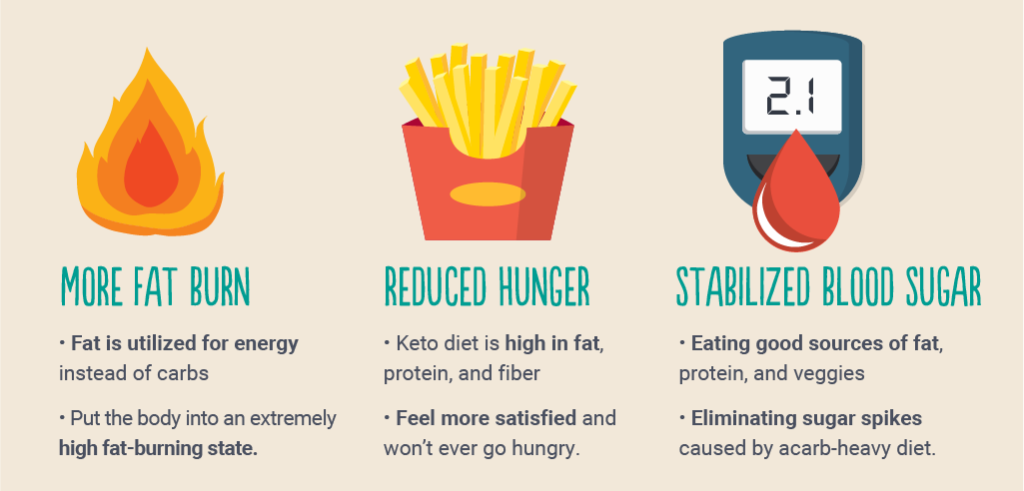
There are a number of health conditions that keto can be helpful for.
Metabolic health
This is the big one and it’s related to weight blood sugar and the fat-storing hormone insulin. These factors all drop and tend to normalize on keto even if they start out high.
The most obvious of these metabolic health conditions beyond obesity is type 2 diabetes. A keto low carb diet is great for reversing type 2 diabetes and it makes perfect sense. If you eat less of what turns into sugar in the body carbs than high blood sugar levels will go down and tend to normalize.
This lowers insulin and when insulin is generally low for a long time insulin resistance improves. There are a number of high-quality studies showing the reversal of type 2 diabetes on keto low carb diets.
Importantly keto is a super powerful tool for people with type 2 diabetes. So powerful that you could become too healthy for your diabetes drugs. So the drugs could drop blood sugar levels too much resulting in low blood sugar which is potentially dangerous.
To avoid this you may have to reduce the doses of any diabetes medication especially insulin. It is critical that you know how to handle this and you should discuss it with your doctor before you start a keto diet so that you can do this right in a safe way.
Type 1 diabetes can also benefit you can’t reverse it or cure it like type 2. But keto can be very helpful to maintain normal blood glucose levels and reduce the need for insulin. People still need insulin but far less.
And again with type 1, it’s very important to know how to correctly decrease insulin doses. So discuss it with your doctor.
Hypertension:
It tends to drop and normalize and this can sometimes happen quickly starting within days. If you’re on blood pressure medication again your blood pressure may become too good to normal for your medication. So the drugs could result in low blood pressure.
You’d have to reduce the dose or stop taking it. Again talk to your doctor about this.
Brain health
Many people use keto for the feeling of constant energy and mental performance they get. But there are also several serious brain disorders that tend to improve in a very empowering way.
Epilepsy:
Keto diets have been used for about 100 years to treat epilepsy in children and it’s become more and more popular. It’s been shown in studies to work about equally well in adults and many people use it to control their epilepsy with less medication or even without it.
And this has important benefits as epilepsy drugs can have side effects like decreased cognitive abilities or even personality changes.
Using keto to be able to decrease or even eliminate the need for medication is a very empowering tool for anyone with epilepsy.
Headaches:
There are a few promising studies already in many stories from people who have dramatically improved their symptoms. It can definitely be worth trying keto for anyone with severe migraines problems.
Some people even report improvement when it comes to ADHD symptoms. Now this condition is less studied and the evidence is still mostly anecdotal but it could be worth testing it to see if symptoms improve.
Gut health
IBS:
One of the most common health problems in the world is IBS or irritable bowel syndrome. The common symptoms include bloating, abdominal pain, cramping, diarrhea, etc. It’s considered a chronic disease with no cure but a very common experience on low carb and Keto diets are that symptom of IBS dramatically improve within days.
And studies show the same thing and there’s a good explanation. Eating fewer carbs and especially certain for mental carbs called their faux DMA piece to result in less gas production in the large intestine reducing bloating cramping etc.
Heartburn:
There are at least two studies showing a positive effect reducing symptoms and making it possible for people to get off their heartburn medication. When it comes to other even more serious gut diseases like Crohn’s disease and ulcerative colitis some people have reported impressive improvements but there are no studies yet to verify this effect.
Some Important References:
The Ketogenic Diet: A Detailed Beginner’s Guide to Keto – by – Healthline
High on fat, low on evidence: the problem with the keto diet – by – TheGaurdian
This Study on Nearly Half a Million People Has Bad News For The Keto Diet – by – ScienceAlert
How does Keto diet plan fit into an Indian meal plan – by TimesOfIndia
Keto diet has potential in military, researchers say – by – OSU.EDU
Keto Diet Is Healthy – As Long As It’s Vegan Says Leading Cardiologist – by – PlantBasedNews
5 of the worst keto diet side effects – by – BigThink
How Much Weight Can You Lose on the Keto Diet? – by -CheatSheet
